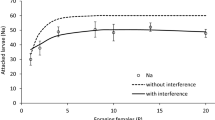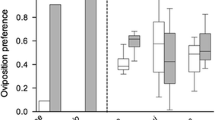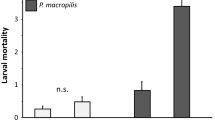Abstract
Fed and unfed first instars of the spined assassin bugSinea diadema were paired to evaluate the effects of food deprivation on their behaviour during encounters. Fed nymphs encountering starved 5-day-old nymphs retreated from 69% of the encounters after contacting the starved nymph. In contrast, starved nymphs initiated grappling during 30% of the encounters with fed nymphs and retreated significantly less often than the fed nymphs. When a single fed nymph was placed together with two unfed 3-day-old nymphs in a closed arena, the fed nymphs generally were not the first nymph cannibalized and were the final survivors in 67% of 24 replicates. These results are discussed in the context of the relative costs and benefits of escalating or retreating from encounters.
Similar content being viewed by others
References
Ambrose, D. P., Solomon, K., and Vennison, S. J. (1985). Effect of competition, space and starvation on the predatory behaviour of the bugRhinocoris marginatus.Environ. Ecol. 3(2): 280–285.
Bailey, P. C. E. (1986). The feeding behaviour of a sit-and-wait predator,Ranatra dispar (Heteroptera: Nepidae): Description of behavioural components of prey capture, and the effect of food deprivation on predator arousal and capture dynamics.Behaviour 97: 66–93.
Beukema, J. J. (1968). Predation by the three-spined stickleback (Gasterosteus aculatus). The influence of hunger and experience.Behaviour 31: 1–126.
Crowley, P. H. (1979). Behaviour of zygopteran nymphs in a simulated weed bed.Odonatologica 8(2): 91–101.
Croy, M. I., and Hughes, R. N. (1991). Effects of food supply, hunger, danger and competition on choice of foraging location by the fifteen-spined stickleback,Spinachia spinachia L.Anim. Behav. 42: 131–139.
Dawkins, R., and Krebs, J. R. (1978). Animal signals: Information or manipulation? In Krebs, J. R., and Davies, N. B. (eds.),Behavioural Ecology: An Evolutionary Approach, Blackwell, Oxford, Melbourne. pp. 282–309.
Duelli, P. (1981). Larval cannibalism in lacewings.Res. Popul. Ecol. 23(2): 193–209.
Fox, L. R. (1975). Cannibalism in natural populations.Annu. Rev. Ecol. Syst. 6: 87–106.
Hardman, J. M., and Turnbull, A. L. (1980). Functional response of the wolf spider,Pardosa vancouveri, to changes in the density of vestigial-winged fruit flies.Res. Popul. Ecol. 21: 233–259.
Holling, C. S. (1966). The functional response of invertebrate predators to prey density.Mem. Entomol. Soc. Can. 48: 1–86.
Kohler, S. L., and McPeek, M. A. (1989). Predation risk and the foraging behaviour of competing stream insects.Ecology 70(6): 1811–1825.
Juliano, S. A., Hechtel, L. J., and Waters, J. R. (1993). Behaviour and risk of predation in larval tree hole mosquitoes: Effects of hunger and population history of predation.Oikos 68: 229–241.
Mulles, M. C. Jr., and Pietruszka, R. D. (1987). Prey selection by a stonefly: The influence of hunger and prey size.Oecologia 72: 473–478.
Morgan, M. J. (1988). The influence of hunger, shoal size and predator presence on foraging in bluntnose minnows.Anim. Behav. 36: 1317–1322.
Otto, C. (1987). Asymmetric competition for cases inAgrypnia pagetana (Trichoptera) larvae.Oikos 48: 253–257.
Otto, C. (1989). Effects of information asymmetries in contests between net spinning caddis larvae (Plectrocnemia conspersa).Oecologia 81: 176–180.
Pastorok, R. A. (1980). The effects of predator hunger and food abundance on prey selection byChaoborus larvae.Limmol. Oceanogr. 25(5): 910–921.
Polis, G. (1981). The evolution and dynamics of intraspecific predation.Annu. Rev. Ecol. Syst. 12: 225–251.
Readio, P. A. (1924). Notes on the life history of a beneficial reduviid,Sinea diadema (Fabr.), Heteroptera.J. Econ. Entomol. 17: 80–86.
Schmidt, J. M. (1994). Encounters between adult spined assassin bugs,Sinea diadema F. (Hemiptera: Reduviidae): The occurrence and consequences of stridulation.J. Insect Behav. 7(6): 811–828.
Sokal, R. R., and Rohlf F. J. (1981).Biometry, 2nd ed., W. H. Freeman, San Francisco.
Taylor, J. R. (1993).Intraspecific Interactions Among First Instar Sinea diadema(F.) (Hemiptera: Reduviidae); With Special Reference to Cannibalism, M.Sc. thesis, University of Guelph, Guelph, Ontario.
Taylor, J. R., and Schmidt, J. M. (1994). Aggression and risk assessment during predatory interactions between first instarSinea diadema (Fabricius) (Hemiptera: Reduviidae).J. Insect Behav. 8(3): 297–311.
Author information
Authors and Affiliations
Rights and permissions
About this article
Cite this article
Taylor, J.R., Schmidt, J.M. The effect of hunger on intraspecific interactions between first-instarSinea diadema (Hemiptera: Reduviidae). J Insect Behav 9, 37–45 (1996). https://doi.org/10.1007/BF02213722
Revised:
Issue Date:
DOI: https://doi.org/10.1007/BF02213722




